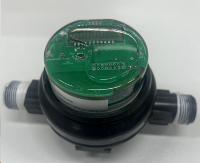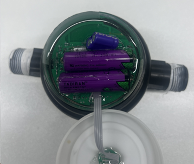3 Types of Antennas for Water Metering and Their Pros and Cons
For IoT and smart utilities, operating with high efficiency and reliability is crucial. This is very important for water metering. The type of antenna technology used is a key factor that affects these qualities.
3 Types of Antennas for Water Metering
Several antenna types have been considered for water metering, including spring, PCB (Printed Circuit Board), and FPC (Flexible Printed Circuit) antennas. Each has its strengths and limitations.
Spring Antennas: While common, they struggle with consistency and are susceptible to metal interference.
PCB Antennas: Offer better integration and performance but can be limited by the water meter's mechanical design and space.
FPC Antennas: Flexible and adaptable, they can be tailored to fit specific design constraints and offer excellent performance.
Read: Water Meter Application LoRaWAN® Range Test Report
Spring Antennas
Spring antennas have been a common choice in the past, but they present significant challenges in the context of water metering. Here are some pros and cons of spring antennas for water meters.
Spring Antennas Pros
1. Easy installation: For installation, the procedure is a simple one. You don’t have to be a professional to install spring antennas.
2. Enhanced Range Potential: The PIFA design of the PCB antenna promised better energy radiation and extended range.
3. Signal Strength Improvement: Tests showed significant improvements in signal strength compared to spring antennas.
Spring Antennas Cons
1. Metal Interference: The proximity to metal components like batteries and capacitors adversely affects antenna performance. Spring antennas are susceptible to interference from nearby metal components, such as batteries and capacitors commonly found in water meters. This proximity can lead to coupling effects, adversely impacting the antenna's performance and, consequently, the meter's communication capabilities.
2. Limited Range: The physical structure and radiation pattern of spring antennas limit their effective range, particularly in dense urban environments where water meters are commonly installed. This limitation poses a significant challenge in ensuring consistent and reliable data transmission over longer distances.
PCB Antennas
PCB antennas are antennas made directly on a circuit board. Instead of being a separate component attached to the board, the antenna is designed as part of the board itself. It's like drawing an antenna onto the circuit board during the manufacturing process. This design saves space and can be customized for specific applications, like in wireless devices such as water meters, where space is limited.


PCB Antennas
PCB Antennas Pros
1. Space Efficiency: PCB antennas are integrated directly into the water meter's circuit board, saving space and reducing the overall size of the device. This is particularly beneficial for water meters, where compact designs are often necessary.
2. Cost-Effectiveness: Incorporating the antenna into the PCB eliminates the need for an additional component, reducing production costs compared to using separate antennas. This cost-effectiveness is advantageous for the mass production of water meters.
3. Customizable: PCB antennas can be customized to match the specific frequency bands and performance requirements of the water metering system. This allows for optimized antenna designs tailored to the application, improving overall performance.
PCB Antennas Cons
1. Limited Range: PCB antennas may have a shorter range compared to larger, external antennas. In environments with obstacles or long distances, the range of communication for water metering systems may be restricted, leading to potential coverage issues.
2. Susceptibility to Interference: Being integrated into the circuit board, PCB antennas may be more susceptible to interference from nearby electronic components, which could degrade signal quality and impact the reliability of communication in water metering applications.
3. Environmental Sensitivity: PCB antennas may be sensitive to environmental factors such as moisture, temperature fluctuations, and humidity. Harsh environmental conditions, common in outdoor installations of water meters, could affect the performance and longevity of PCB antennas.
FPC Antennas
FPC antennas are thin, flexible antennas made from a special type of material called a flexible printed circuit. Unlike traditional rigid antennas, FPC antennas can bend and conform to different shapes, making them ideal for applications where space is limited or where flexibility is needed.
FPC Antennas Pros
1. Space Efficiency: FPC antennas are thin and flexible, allowing them to be integrated into compact water meter designs without occupying much space. This is particularly beneficial for water meters installed in tight locations or small enclosures.
2. Durability: Designed to endure harsh environments like those found in water metering applications, FPC antennas maintain performance despite bending, mechanical stress, vibrations, temperature changes, and moisture exposure.
3. Adaptability: Customization of FPC antennas allows them to be perfectly tailored to the specific contours and sizes of the water meter housing. This precision fit enhances their functionality, ensuring they provide excellent signal transmission and reception across different installation situations.
4. Enhanced Range and Reliability: In urban environments, FPC antennas have demonstrated superior performance, providing reliable long-range communication that is essential for effective water metering. They have been proven to achieve impressive ranges, such as a 10km LoRaWAN range in city settings.
5. Comprehensive Coverage: FPC antennas have shown the ability to provide comprehensive building coverage, ensuring reliable readings on every floor, and an extended street-level range, surpassing expectations in urban street tests.
FPC Antennas Cons
1. Mechanical and Spatial Constraints in Water Meters: Despite their flexibility, integrating FPC antennas into existing water meter designs can still present challenges. The need to accommodate the antenna within the mechanical structure of water meters requires careful planning and design.
2. Complexity of Integration: Integrating FPC antennas into water meter designs may require specialized expertise and careful planning. Ensuring proper alignment and positioning of the antenna within the meter housing can be challenging and may add complexity to the manufacturing process.
3. Cost: FPC antennas may incur higher manufacturing costs compared to simpler antenna solutions. The materials and manufacturing processes involved in producing FPC antennas can contribute to overall production expenses for water meter manufacturers.
Conclusion
Choosing the right antenna is fundamentally linked to ensuring the continuous effectiveness and dependability of smart utility services. Among various options, FPC antennas stand out due to their innovative design and functional excellence. This is a key indicator for urban water metering as we move towards more intelligent urban environments.
Frequently Asked Questions
What is a water meter antenna?
A water meter antenna helps smart water meters wirelessly send usage data to the utility company, allowing for remote monitoring. There are different kinds like Spring, PCB, and FPC Antennas, each with unique benefits in how strong they can send signals, how flexible they are, and how easily they fit into designs.
What is the purpose of water metering?
Water metering aims to precisely track water use for fair billing, encourage saving water by sharing detailed usage info with users, and assist utilities in finding leaks and better managing water supplies.
What are the benefits of smart water metering?
Smart water meters bring multiple advantages, such as continuous tracking of water use, better finding and stopping leaks, helping to save more water, ensuring water bills are precise based on exact use, and providing improved information for managing water supplies effectively.
What are the disadvantages of smart water meters?
Smart water meters have downsides like costly setup, privacy worries from data gathering, and regular maintenance needs, and some people might resist using them due to unfamiliarity or distrust in smart tech.



